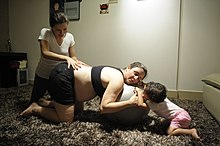Doula
A doula (from ancient Greek δούλη doúlē , German 'servant, slave, maid' ) is a non-medical helper. She stands by an expectant mother emotionally and physically before, during and after the birth .
History of the job description
In Western culture, the concept of the doula was first revived in the United States. The term was used in an anthropological study by Dana Raphael in 1969 . Margaret Mead's student had adopted the term doula from an elderly Greek woman. The United States has traditionally had very few midwives in hospitals. If there are no complications, mothers are discharged home shortly after giving birth. In Germany and Austria, doulas were not very well known in the 2010s. In Switzerland, the level of awareness has increased significantly.
tasks
Supporting pregnant women has a tradition that goes back thousands of years. Doulas see themselves as companions for pregnancy , childbirth and the puerperium . They look after the woman before, during and after the birth of a child, support the partner and help both of them to cope emotionally with the situation. You can ensure continuous 1: 1 care during the birth. Doulas do not take on any medical activities and do not replace midwives or medical obstetricians. In some cultures, in addition to the midwife, one or more doulas are present to assist with childbirth.
Practical support for parents and newborns after the birth, including looking after siblings, is more a part of home care for young women and babies . In comparison, a doula deals with emotional events before and immediately after birth. The pregnant woman contacts a doula herself and pays for it privately. The costs are not borne by the health insurance companies in Germany either.
education
A doula is trained in courses that last about a year. Practical experience is part of the training.
Doulas work full-time or part-time. It is widely regarded as a basic requirement for the activity that a doula has given birth to a child himself. Some clubs in Switzerland, Austria and Germany only offer training for women. Since 2017 there have also been training opportunities for men and women without childbirth experience. There are a few male doulas. Training as a midwife, however, is also open to men without reservation. In 2010 there was only one male obstetrician in Germany.
In Germany and Austria, doula training is organized by private associations. The entry requirements are different, and the training is not organized by the state in Germany, Austria and Switzerland. It has to be paid privately. Since the term doula is not protected, it is possible to be a doula even without training.
In contrast, midwifery training with midwifery laws in Germany and Austria also includes courses with bachelor's degrees.
Doula associations
The DONA International association is the largest and oldest doula association in the world. It has existed since 1992 and had certified more than 12,000 doulas in more than 50 countries by 2019. In Austria, Germany and Switzerland there are several doula associations and several providers for doula training.
Definition of terms
In a different usage of the word, an accompaniment at the end of life ( terminal care ) is sometimes also referred to as a "doula".
literature
- Amy L. Gilliland: Beyond holding hands: the modern role of the professional doula. J Obstet Gynecol Neonatal Nurs 31 (2002), pp. 762-769, PMID 12465873 doi : 10.1177 / 0884217502239215
- Marshall H. Klaus, John H. Kennell, Phyllis H. Klaus: Doula, the new way of childbirth care. Mosaik Verlag, Munich 1995.
Individual evidence
- ^ Maggie Jones: Dana Raphael Opened Up the Mysteries of Nursing - The New York Times. In: nytimes.com. December 21, 2016, accessed January 12, 2019 .
- ↑ Sabrina Ebitsch: Profession of the Week: Doulas - Until the beautiful end. In: zeit.de. August 6, 2009, accessed January 10, 2019 .
- ↑ Christina Horsten: German Doula in New York: Midwife in a country without midwives. In: aerztezeitung.de. December 27, 2018, accessed January 10, 2019 .
- ↑ Claudia Hamburger: Birth accompaniment: What does a doula actually do? In: t-online.de. September 12, 2018, accessed January 10, 2019 .
- ↑ Position paper on the subject of doulas in Germany. (PDF; 43.07 kB) In: hebammenverband.de. Deutscher Hebammenverband eV, September 2010, accessed on January 10, 2019 .
- ↑ Household: Male Doula ?? In: forum.wireltern.ch. Retrieved January 10, 2019 .
- ↑ Yaniv Kubovich: Birth instructor suspected of sexually abusing patients - Haaretz - Israel News. In: Haaretz.com. December 27, 2010, accessed January 10, 2019 .
- ↑ Susanne Kailitz: Male midwives: Alone among women. In: zeit.de. July 8, 2010, accessed January 10, 2019 .
- ↑ About DONA International. In: dona.org. Retrieved January 10, 2019 .
- ↑ Michele C. Balas, Melissa Gale, Sarah H. Kagan: Delirium Doulas. An Innovative Approach to Enhance Care for Critically Ill Older Adults. In: ccn.aacnjournals.org. August 2004, accessed January 12, 2019 .
